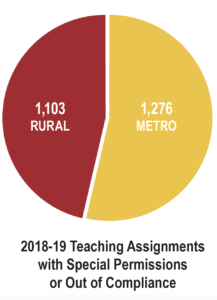Teacher shortages continue to grow across the state, especially in rural areas and key subject areas. The 2019 Minnesota Teacher Supply and Demand Report found that:
- Six rural Economic Development Regions had the greatest percentage of teacher shortages. Learn more about shortage areas.
- Teachers for special education and early childhood led the gaps statewide.
- 25 percent of the 7,000 teachers who left the profession in 2016-17 cited personal reasons.

This has led to an increasing number of teaching assignments with special permissions or out of compliance assignments in both rural and metro areas, as shown by the pie chart.
The Greater Minnesota regions had an average of 3.7. The percentages of special permissions and assignments out of compliance are highest in the rural corners of the state:
- Northwest: 7.5
- Southwest: 6.9
- Northeast: 6.2
Schools have worked to address shortages and seen some results:
- 45 percent of school districts reported that creating a pipeline program (residency models, grow your own) made some or a significant difference in recruiting and retaining standard licensed teachers.
- 69 percent of school districts reported that providing mentorship programs made some or a very big difference in retaining teachers.
What’s Needed
Addressing this critical shortage and providing quality teachers requires a multi-faceted approach, including:
- Teacher loan forgiveness
- State grants for student teachers
- Regional and rural grow-your-own program(s) available to school districts
- Establish and strengthen mentoring programs for new teachers





